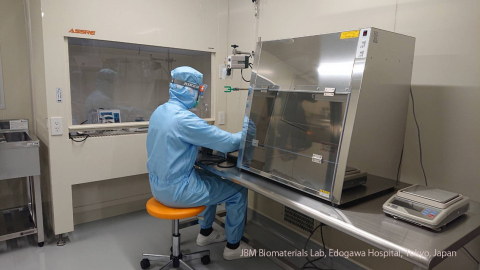Urethrale strictuurbehandeling door hybride celtherapie, verleend Japans octrooi
De pijnloze en eenvoudige dagbehandeling maakt de Bees-Haus-techniek geschikt voor wereldwijd bereik
TOKYO– (BUSINESS WIRE) – Behandeling van vernauwing van de mannelijke urethra met de eigen mondslijmvliescellen van de patiënt, ingekapseld in een polymeersteiger als drager, is in Japan gepatenteerd. Een langere periode van verlichting bij patiënten die de ziekte terugkeerden na eerdere conventionele behandelingen, is gemeld door deze methode genaamd “Bees-Haus” (Buccaal epitheel uitgebreid en ingekapseld in de steigerhybride benadering van urethrale strictuur; https://onlinelibrary.wiley.com/doi/full/10.1111/iju.13852).
Urethra, een buisvormige doorgang om de urine te laten uit urineblaas, wanneer aangetast door vernauwing of vernauwing van de lumen, veroorzaakt moeilijkheden bij het plassen urine, urineretentie en pijn tijdens mictie. Behandelingen omvatten dilatatie met ballon of urethrotomie onder endoscopie in vroege stadia en chirurgische urethroplastiek onder algemene anesthesie met gebruikmaking van het autologe orale / buccale weefseltransplantaat van de patiënt bij ernstige ziekte of vernauwing van het lange segment. Na een operatie passeren patiënten een tijdje urine via katheterafvoer en complicaties zoals strictuurherhaling, urineweginfectie, impotentie, seksuele disfunctie en incontinentie zijn gemeld (Gallegos & Santucci F1000Res.2016; 5-2913 & Barbagli et al. Europese supplementen voor urologie 2016; 15-1).
Urethral Stricture Treatment by Hybrid Cell Therapy, Granted Japanese Patent
Painless & simple day-care procedure makes Bees-Haus technique suitable for global reach
TOKYO–(BUSINESS WIRE)– Treating male urethral stricture with the patient’s own buccal mucosal cells, encapsulated in a polymer scaffold as carrier, has been granted a patent in Japan. A longer duration of relief to patients who had recurrence of the disease after earlier conventional treatments, has been reported by this method called “Bees-Haus” (Buccal epithelium Expanded and Encapsulated in Scaffold‐Hybrid Approach to Urethral Stricture; https://onlinelibrary.wiley.com/doi/full/10.1111/iju.13852).
This press release features multimedia. View the full release here: https://www.businesswire.com/news/home/20200701006026/en/

Biomaterial research facility of JBM in Tokyo, where improvised scaffolds for regenerative medicine applications like Bees-haus, implants and medical devices are developed. (Photo: Business Wire)
Male urethra, a tubular passage to let the urine out from urinary bladder, when affected with narrowing or stricture of the lumen, causes difficulty in voiding urine, urinary retention, and pain during micturition. Treatments include dilatation with balloon or urethrotomy under endoscopy at early stages and surgical urethroplasty under general anesthesia using patient’s autologous oral/buccal tissue graft in severe disease or long segment stricture. After surgery, for a while, patients pass urine through catheter drainage and complications such as stricture recurrence, urinary tract infection, impotence, sexual dysfunction, and incontinence, have been reported (Gallegos & Santucci F1000Res. 2016;5-2913 & Barbagli et al. European Urology Supplements 2016;15-1).
Bees-Haus method of cell therapy could be performed in two-steps, both as day care procedure. A small bit of patient’s oral tissue is taken, cells cultured in lab, and transplanted through endoscopy. Very simple and convenient for urologist and relatively painless to patients with shorter hospital stay reducing healthcare cost and burden, because of lesser complications, making Bees-Haus easy to adopt. A larger multicentric study is under proposal by JBM Inc, to validate its efficacy to make this a routine procedure to benefit many patients with better quality of life.
Urethral stricture disease occurs mainly in men and its incidence climbs sharply after 55 years in western population. An estimated 0.6% in susceptible populations are affected in which 4% of male patients require interventional procedure. Annually 200 million USD is spent in USA for urethral stricture treatment, which doesn’t include cost of medication. The Americas hold the largest share in the global urethral stricture market, followed by Europe and Asia Pacific. JBM has applied for patents worldwide including USA, EU, United Kingdom and are looking for country-wise partners for technology licensing out. JBM also established a biomaterial laboratory to develop novel scaffolds for various applications in regenerative medicine, implants, and medical devices in Tokyo.
View source version on businesswire.com: https://www.businesswire.com/news/home/20200701006026/en/
Contacts
Queries to:
GN Corporation Ltd.
Samuel JK Abraham

